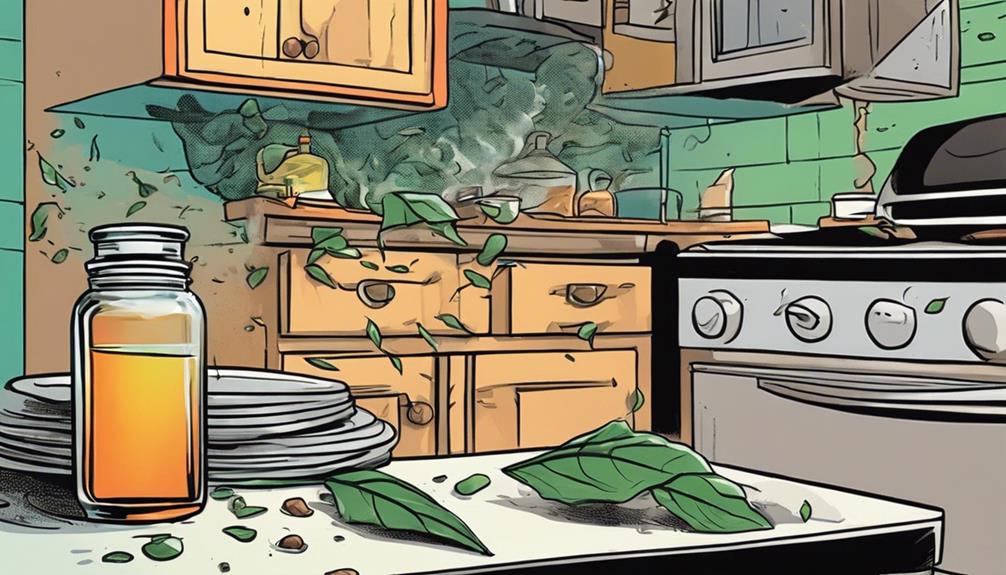To rid your kitchen cabinets of a cockroach infestation, start by identifying signs of roaches like frass and live insects. Clean cabinets and vacuum thoroughly to eliminate hiding spots, utilizing homemade remedies like borax powder or peppermint oil. Place traps strategically in high-traffic areas and seal off access points with caulking or weather stripping. Check for water leaks and remove food sources to deter roaches. Apply gel bait in cracks and crevices and consider professional pest control services if needed. Implement these steps diligently. Additional effective strategies await further exploration.
Key Takeaways
- Inspect cabinets at night for signs of roaches.
- Clean cabinets thoroughly to remove hiding spots.
- Use homemade remedies like borax or peppermint oil.
- Place traps in high-traffic areas to monitor infestation.
- Seal access points and fix water leaks to prevent infestations.
Identifying Cockroach Infestation
Inspect your kitchen cabinets for signs of cockroach infestation by checking for frass, broken body parts, and live roaches. Use a flashlight to peek into cracks and crevices where roaches might hide.
If you spot a single roach, it could indicate a more extensive infestation. Nighttime is vital for inspections as roaches are most active then. Keep an eye out for live roaches scurrying around or any other indicators of their presence.
These pests can contaminate your food and spread diseases, so it's essential to address the issue promptly. By identifying the signs early on, you can take the necessary steps to eliminate the cockroach infestation from your kitchen cabinets.
Cleaning and Vacuuming Cabinets

To effectively combat a cockroach infestation in your kitchen cabinets, begin by thoroughly cleaning and vacuuming to eliminate potential hiding spots and food sources for these pests. Cockroaches are attracted to food crumbs and debris, so regularly cleaning your cabinets is vital in reducing their access to a food supply.
Vacuuming helps remove cockroach eggs, feces, and shed skins that contribute to infestations. When cleaning, pay attention to tight spaces and corners where roaches may hide by using a vacuum with a crevice tool. This step is essential in preventing reinfestation and maintaining a hygienic kitchen environment.
Using Homemade Remedies

Consider utilizing homemade remedies to naturally combat cockroach infestations in your kitchen cabinets. Homemade remedies offer a cost-effective and environmentally friendly way to tackle these pests. Here are some DIY solutions you can try:
| Homemade Remedy | Description | Benefits |
|---|---|---|
| Borax Powder | Mix with sugar to create a potent roach killer. | Effective at eliminating roaches. |
| Eggshells | Ground into a powder, they deter roaches due to their sharp edges. | Natural and safe repellent. |
| DIY Mixture | Combine baking soda and sugar to attract and kill roaches. | Simple yet effective solution. |
| Peppermint Oil | Mix with water and spray in cabinets to repel roaches. | Pleasant smell while keeping roaches away. |
| Vinegar Solution | Use a vinegar and water solution to clean cabinets and deter roaches with its strong smell. | Doubles as a cleaning agent and repellent. |
These homemade remedies provide a proactive approach to managing cockroach infestations in your kitchen cabinets.
Placing Cockroach Traps

Homemade remedies can be effective, but complementing your efforts by placing cockroach traps in kitchen cabinets is a proactive step towards monitoring and controlling roach activity. Here are some tips for effectively using cockroach traps in your kitchen:
- Strategic Placement: Position traps in high-traffic areas such as under sinks and behind cabinets to increase the chances of catching roaches.
- Regular Monitoring: Check the traps frequently to gauge the severity of the infestation. This monitoring provides valuable insights into the extent of the roach activity.
- Glue Traps: Opt for glue traps in small spaces where roach activity is suspected. These traps are safe and efficient in capturing roaches discreetly.
- Assessing Treatment Progress: Traps not only help in trapping roaches but also act as indicators of treatment progress. Monitoring the traps can help identify areas with persistent roach activity, guiding your pest control efforts effectively.
Sealing Access Points

To prevent cockroaches from sneaking into your kitchen cabinets, make sure to seal gaps thoroughly, caulk around pipes, and use weather stripping.
Gaps and crevices in cabinets create easy access points for these pests, so it's important to seal them off effectively. By caulking gaps and cracks and ensuring a tight seal, you can eliminate hiding spots and reduce the likelihood of a cockroach infestation.
Seal Gaps Thoroughly
Seal gaps in your kitchen cabinets with a caulking gun to effectively block off access points for cockroaches.
Here are four steps to help you eliminate potential access points and create barriers for these pests:
- Inspect for Cracks and Crevices: Check your cabinets thoroughly for any cracks or crevices that could serve as entry points for cockroaches.
- Utilize a Caulking Gun: Use a caulking gun to seal off these openings, ensuring a tight seal that prevents roaches from getting in.
- Fill Larger Gaps with Shims: For larger gaps that may be present, consider using shims to fill them in and further fortify your cabinets against pests.
- Tighten Cabinet Hardware: Make sure all cabinet hardware is securely tightened to create a seamless barrier that cockroaches can't breach.
Caulk Around Pipes
How can caulking around pipes effectively prevent cockroaches from entering your kitchen cabinets?
Caulking around pipes helps seal off the entry points that cockroaches utilize to access your cabinets. These pests are adept at squeezing through even the tiniest of gaps, making caulking a vital method to prevent their intrusion.
By sealing these gaps, you create a barrier that deters cockroaches from hiding and breeding within your kitchen cabinets. This maintenance task not only eliminates access points but also helps in controlling potential cockroach infestations.
Caulking isn't only cost-effective but also an efficient way to make sure that your cabinets remain free from these unwanted visitors. Remember to regularly inspect and caulk around pipes to maintain a strong defense against cockroach infestations in your kitchen cabinets.
Use Weather Stripping
By using weather stripping, you can effectively seal off access points that cockroaches exploit to infiltrate your kitchen cabinets. Here are four key ways weather stripping can help you rid your kitchen of these pests:
- Preventing Entry: Weather stripping can be used to seal gaps around doors and windows, denying cockroaches easy access to your kitchen cabinets.
- Blocking Off Access Points: By creating a tight seal with weather stripping, you can block the entry points that cockroaches typically use to infiltrate cabinets.
- Reducing Infestation Risks: Maintaining a secure barrier with weather stripping minimizes the likelihood of cockroach infestations in your kitchen.
- Inhibiting Hiding Spots: Sealing access points with weather stripping not only keeps cockroaches out but also limits their hiding spots within your cabinets, making it harder for them to thrive.
Implementing weather stripping not only helps in getting rid of cockroaches but also contributes to better energy efficiency in your home.
Removing Food and Water Sources

To eliminate food sources for cockroaches, make sure food disposal methods are prompt and secure, reducing the availability of crumbs and spills.
Inspect your kitchen for water leaks that could create standing water, a prime attractant for roaches seeking hydration.
Regularly clean and dry the interiors of your cabinets to remove any food residue that might entice roaches to infest your kitchen space.
Food Disposal Methods
One effective way to combat cockroach infestation in your kitchen cabinets is by properly disposing of food and water sources. To achieve this, follow these steps:
- Remove Food: Clear out all food items from your cabinets to deprive cockroaches of a food source.
- Wipe Down Cabinets: Regularly clean and wipe down your cabinets to eliminate crumbs and spills that attract roaches.
- Fix Leaky Pipes: Address any leaky pipes promptly and remove any standing water to deny roaches access to moisture.
- Store Food in Airtight Containers: Keep all food stored in airtight containers to prevent roaches from reaching it.
Water Leak Inspection
Inspect for water leaks under sinks in your kitchen cabinets to eliminate potential moisture sources that attract cockroaches. Water leaks provide the perfect environment for cockroaches to thrive, so it's important to inspect for leaks in pipes or faucets.
By identifying and fixing leaks promptly, you can eliminate the water sources that these pests need to survive. Removing water leaks in cabinets will make the environment less welcoming for cockroaches, reducing the chances of an infestation.
Cockroaches are drawn to moisture, making it essential to address any leaks to prevent them from being attracted to your kitchen cabinets. By taking the time to inspect for leaks and ensuring they're fixed promptly, you can greatly reduce the risk of a cockroach infestation.
Cleaning Cabinet Interiors
Check your kitchen cabinets for any food residues or spills that could be attracting cockroaches, then thoroughly clean the interiors to remove these potential food sources.
To make certain your cabinets are free of enticing treats for these pests, follow these steps:
- Remove all items: Take everything out of the cabinets to access hidden areas where cockroaches might be lurking.
- Wipe down surfaces: Use warm water and soap to eliminate food residues and odors that can attract cockroaches.
- Dry thoroughly: After cleaning, guarantee cabinets are completely dry before putting items back to prevent moisture buildup that cockroaches are drawn to.
- Regular maintenance: Check cabinets regularly for leaks, spills, and food debris to prevent future cockroach infestations.
Applying Cockroach Gel Bait

To effectively apply cockroach gel bait in your kitchen cabinets, start by identifying cracks and crevices where the pests are likely hiding. This method is highly effective in eliminating cockroaches as the gel bait attracts them, disrupting their breeding cycle. By placing small dots of the bait in strategic areas, you can target the roaches where they hide and prevent further infestation. The gel bait is safe for indoor use and provides long-lasting control, making it a popular choice for tackling cockroach problems. Remember to regularly replenish the bait to guarantee continuous elimination of cockroaches in your cabinets.
| Advantages | Considerations |
|---|---|
| Effective in attracting roaches | Avoid placing bait where pets or children can access |
| Disrupts cockroach breeding cycle | Keep bait away from food preparation areas |
| Long-lasting control | Check and replace bait as needed |
Seeking Professional Pest Control

Consider hiring professional pest control services, such as Hawx Pest Control, to efficiently address and eliminate cockroach infestations in your kitchen cabinets. Here are four reasons why seeking professional help is beneficial:
- Proven Methods: Professional pest control services have experience in dealing with cockroach infestations and use effective techniques to eliminate these pests from your kitchen cabinets.
- Quality Products: Technicians from reputable companies utilize high-quality products that are specifically designed to eradicate cockroaches, ensuring a thorough elimination process.
- Preventive Measures: Professional services not only focus on getting rid of existing infestations but also implement preventive measures to avoid future cockroach problems in your kitchen cabinets.
- Qualified Technicians: Hiring pest control experts guarantees that qualified technicians, equipped with the necessary knowledge and tools, will handle the cockroach infestation efficiently and effectively.
Frequently Asked Questions
How to Get Rid of Cockroaches in Cabinets?
To get rid of cockroaches in cabinets, clean thoroughly, set traps strategically, seal cracks, apply diatomaceous earth or boric acid, and inspect regularly. Follow these steps to eliminate roaches and prevent infestations in your kitchen.
What Kills Cockroaches Instantly in the Kitchen?
To kill cockroaches instantly in the kitchen, use aerosol pesticides to flush them out of hiding spots. Baits with fipronil work quickly, while boric acid and diatomaceous earth desiccate them fast. Roach sprays with pyrethroids provide immediate knockdown.
Can You Put Roach Bait in Cabinets?
You can definitely put roach bait in cabinets. Strategically placing it in corners, cracks, and near water sources is key. Regularly monitoring and replacing the bait helps control infestations discreetly and effectively.
How Do I Clean My Kitchen After a Roach Infestation?
You're determined to reclaim your kitchen after the invasion. Vacuum meticulously, wipe down with warm water and soap, and dry thoroughly. Don't restock until it's spotless. Following these steps will banish roaches for good.
Conclusion
To sum up, getting rid of a cockroach infestation in your kitchen cabinets requires a multi-step approach. By identifying the infestation, cleaning and vacuuming cabinets, using homemade remedies, placing traps, sealing access points, removing food and water sources, applying gel bait, and seeking professional help if needed, you can effectively eliminate these pests.
Remember, a clean and well-maintained kitchen is key to keeping cockroaches at bay. Stay vigilant and proactive in your pest control efforts.







